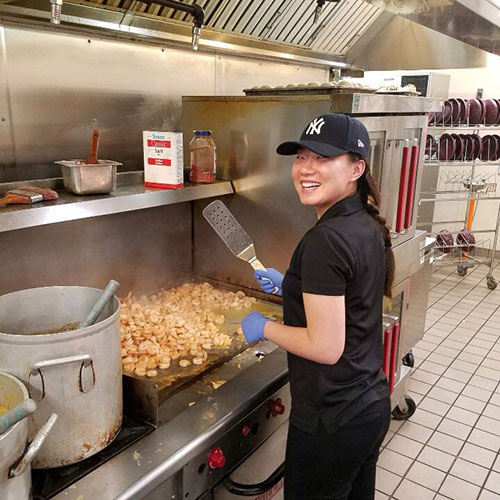Research
A Quality Cut

As American fast food restaurants duke it out for dominance in the chicken sandwich wars, MAFES researchers are hard at work ensuring that the poultry products those restaurants need are of the highest quality. One particularly pesky quality issue is known as woody breast, which as the name suggests, leaves the chicken with a wood-like texture of varying severity. The team sought to identify differences found in protein expression, biological pathways, and the microbial composition of the gut between unaffected birds and birds with woody breast. Specific genetic varieties were found to be more vulnerable to the woody breast condition, and environment, diet, gut microbiome, and others were some of the factors impacting woody breast.
A Versatile Protein

From crayons to soymilk to animal feed, soybeans are versatile and a mainstay in Mississippi agriculture. The row crop is one of the state's top commodities, with a value of $1.21 billion in 2020. While the legume is used in a variety of products, perhaps the most popular food derived from soybean is tofu. In a process similar to cheesemaking, tofu is made of coagulated soy milk that is formed into solid white blocks with or without pressing. Tofu is classified by texture, where the firmness dictates how likely it is to retain its structure under various cooking methods. In a project that has lasted nearly ten years, MAFES scientists have been on a mission to find the best soybean cultivar for tofu production. They have studied and grown dozens of soybean varieties across three states in an effort to find the best cultivars for growers. By growing food-grade soybeans that can translate to high-quality tofu, MAFES researchers believe growers can increase their selling price significantly.
An Anti-Aging Ally

Researchers at MAFES have been tackling the understanding of a little-known mineral known as selenium, which can be found in foods such as Brazil nuts and seafood. Selenium has a role in a large number of the body's digestive and metabolic processes, but this study specifically hopes to understand the link between type-2 diabetes and inadequate selenium levels. The research suggests that, though the majority of people maintain an optimized selenium level through healthy eating, those whose levels are slightly too low may experience accelerated aging—and specifically the onset of type-2 diabetes—if their numbers remain elevated for a prolonged period.
Beyond hunger

Food insecurity impacts 8.5 percent of adults age 65 and older in the U.S. That percentage climbs to 12.3 in Mississippi, the state with the greatest number of older adults who experience some level of food security. David Buys, researcher in the Mississippi Agricultural and Forestry Experiment Station and health specialist with the MSU Extension Service, recently authored a chapter about food insecurity and older Americans in the third edition of the "Handbook of Clinical Nutrition and Aging" published by Humana Press. The chapter discusses how food insecurity impacts public health. Buys is conducting research on programs for people returning home from the hospital. His study has found that the health implications of food insecurity in older adults are considerable, specifically for those who have been admitted to the hospital for treatment of chronic conditions such as diabetes and hypertension. Buys said food insecurity increases these individuals' chances of returning to the hospital.
Read moreCracking the Shell

An estimated 32 million Americans live with food allergies, one of the most common of which being peanuts. MAFES researchers hope to mitigate this problem by studying the legume itself. What makes peanut allergies so potent are the multiple allergens present in the legume. This study compared the concentration of the four major allergens found in peanuts across 122 varieties and found nine of those varieties had reduced amounts of allergens. They also studied how various preparation methods such as frying, baking, and broiling are more affect the potency of the peanut's allergens, as well as how enzymes could be used to minimize allergens.
Dressing Ham
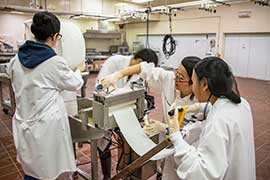
A Mississippi Agricultural and Forestry Experiment Station scientist in the School of Human Sciences is hamming it up with a MAFES food scientist, an entomologist at Kansas State University, and an agricultural economist at Oklahoma State University. Fashion and food have joined forces to design ham nets that will protect dry-cured ham from mites. The idea for the project began several years ago when scientists in the MSU Department of Food Science, Nutrition and Health Promotion and Kansas State University developed a food-grade, patent pending solution that successfully deters mites. Dr. Wes Schilling and Dr. Charles Freeman then had to figure out the best way to apply the solution so that it provided continuous protection to the ham. By saturating the stockings with the solution and then allowing the hams to hang in the netting, the scientists have come up with an easy application process to help dry-cured ham producers find economical alternatives to using methyl bromide that has been steadily phased out of use due to it being an ozone depleting substance.
Extending shelf life and food safety
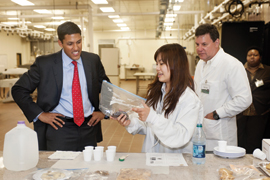
Increasing the length of time fresh catfish fillets can spend in the supply chain would make it more feasible for processors to offer fresh, never-frozen, tray-packed products in the retail market. MAFES scientists Taejo Kim, Juan Silva, and Byron Williams tested the effectiveness of antimicrobials and antioxidants at enhancing the safety and shelf life of fresh, vacuum-tumbled catfish fillets. They found that marinating fillets with salt, an agglomerated phosphate blend, and a combination of commercially available potassium acetate and potassium lactate is an effective strategy for inhibiting growth of the bacteria that cause spoilage in refrigerated foods. Analysis by food scientist Wes Shilling revealed that this treatment enhances the sensory acceptability of fried catfish fillets. Treatment with antimicrobials did not detract from the acceptability of the marinated fillets
Front line of food safety
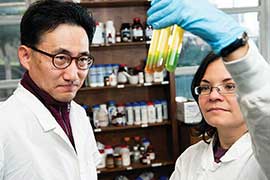
According to the Centers for Disease Control and Prevention, foodborne pathogens cause an estimated 47.8 million illnesses, 128,000 hospitalizations and 3,000 deaths in the U.S. each year. Taejo Kim, scientist in the Mississippi Agricultural and Forestry Experiment Station and assistant research professor in the Department of Food Science, Nutrition and Health Promotion, has discovered a way to make industry-wide testing of Salmonella, Listeria, E.coli and certain strains of Vibrio fast, easy and affordable. His rapid test kits require no analytic instruments; can detect pathogens in 24 hours or less and are extremely reliable. Additionally, the kits culture whole cells so technicians don't have to be skilled in extracting DNA, making it easier to use than other commercial test kits currently on the market.
Fruit of the Vine

MAFES scientists, Dr. Eric Stafne and Dr. Sam Chang, are working to bring a sweet treat to Mississippi's farms. Fruits such as bunch grapes, muscadines, and blackberries, are native to the state, but have not had much success in large-scale production due to disease and harvesting difficulties. Stafne's main research has been evaluating bunch grape cultivars to see how they perform in Mississippi where there is an endemic disease called Pierce's disease (Xylella fastidiosa), which infects grapes via insect transmission. Blackberry growers also face challenges, in the form of pests and genetic disorders. As for muscadines, the biggest difficulty is in production cost. However, Dr. Sam Chang's research on the health benefits of muscadines suggests that it may be worth it. Compared to other grapes, muscadines are high in antioxidant properties, and they also have several other health benefits that could make it an up-and-coming superfood. Chang's next step will be determining which portions of the grape contain the highest concentrations of ellagic acid and antioxidants.
Grass-fed
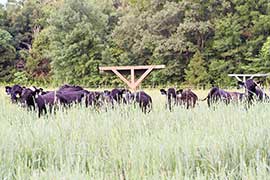
As consumer interests for forage-finished beef increases in the U.S., Mississippi Agricultural and Forestry Experiment Station scientists, Wes Schilling and Byron Williams, are studying different forages and the effects on beef quality and taste. Scientists conducted one study in the Experiment Station's Prairie Research Unit, examining the quality of beef foraged on native grasses and bermudagrass. In a separate study, scientists compared grain-finished and forage-finished cattle. In both studies, researchers found that native warm-season grasses are acceptable forage for beef cattle during the stocker phase, producing a lean, high protein product with positive consumer acceptability.
Hunger at Home

Nationally, one in six seniors struggle with hunger, according to Meals on Wheels America. Scientists and students in the Mississippi Agricultural and Forestry Experiment Station and the College of Agriculture and Life Sciences are investigating current trends in food access for seniors in order to help address hunger right here at home. Josh Turner, a recent doctoral candidate in human development and family studies with a gerontology emphasis, studied senior low access food as part of his doctoral dissertation. Turner analyzed data from the U.S. Census and the Department of Agriculture and determined factors that best predicted low food access among seniors in rural and non-metropolitan areas. He used the U.S. Department of Agriculture's metric for low food access: a household's proximity to a supermarket.Turner found that a persistent rate of county outmigration was the strongest predictor of an area being classified as a senior low food access county. While Turner is studying low food access across the U.S., Dr. David Buys, who specializes in gerontology, has long been interested in research focused on a particular program for food-insecure seniors: Meals on Wheels. Currently, almost 20,000 Mississippi seniors are served through Meals on Wheels programs. Seventy-two percent of those individuals live in poverty; almost 50 percent belong to a minority group, and 80 percent live in a rural community. To contribute to that body of science, Buys is currently partnering with Morrison Healthcare, the company that provides nutrition services for OCH Regional Medical Center. The researchers are currently enrolling individuals into a feasibility study in order to determine whether frozen meals given to seniors on hospital discharge will decrease the rate of hospital readmissions.
Improving food safety from production to consumption

Food scientist Byron Williams, who spent 15 years in the food-processing industry before beginning his career at Mississippi State, focuses on food safety and value enhancement in his research and through educational workshops for processors and associated agencies. In a recent project, Williams studied pork processed through "hot boning," in which meat is removed from a carcass before chilling. He examined the effects of combining commonly used antimicrobial ingredients on the quality, bacterial content, and sensory characteristics of sausage patties made from hot-boned pork. Williams's study found the experimental patties were acceptable in all these traits, in addition to having an extra 3 days of shelf life. Other ongoing research explores strategies for improving quality and safety of raw materials and methods used in many Southeastern food-processing plants.
Local food in the hands of locals
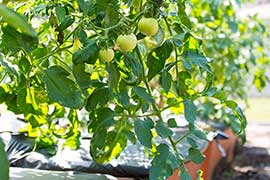
Limited access to fresh produce is an issue that plagues disadvantaged communities throughout the United States. Dr. Marie Allsopp, former assistant professor and director of MSU's Didactic Program in Dietetics, studied an initiative in the state of New York. The work there could potentially serve as a model for places like Mississippi, by helping address food access issues by giving food banks money to purchase from local producers. After the initial success with the program called the Hunger Prevention and Nutrition Assistance Program, which supplies food and financial support for the emergency food network throughout the state of New York, Allsopp is researching how the program can be replicated in other states, particularly in a state like Mississippi, which has a long growing season and plenty of agriculture. "It could be a win-win situation where farmers have regular support from food banks purchasing their produce, and people have greater access to fresh produce," Allsopp said. In Mississippi, the need to get people eating healthy is pressing. The state is one of the top five most obese states in the country and has the highest rate of diabetes and hypertension. An unhealthy diet is one factor that can contribute to or exacerbate these issues. Local foods can play a role in this transition by providing healthy options to begin with—and a program like the locally grown produce initiative Dr. Allsop studied in New York could help along the path to a healthier Mississippi.
Preserving the Catch

The quality of catfish decreases dramatically after a mere 72 hours of sitting on grocery store shelves. With catfish bringing in $226 million in production value for the state, MAFES researchers are diligently searching for ways to better preserve our catfish. In particular, this study is interested in the effects of chitosan, a substance derived from shellfish and crustaceans. The scientists applied chitosan to the catfish to see if it increased its shelf life. Though the study has yet to complete all of its trials, there was a significant increase in catfish shelf life once chitosan was applied.
Promoting easy detection of food-borne pathogens
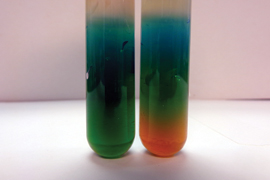
Food scientists Tae Jo Kim and Juan Silva developed a simple test kit that can be used to detect Salmonella in food, water, and environmental samples. This unique detection mechanism consists of a single test tube that can expose the presence of Salmonella in a sample without the need for any additional equipment. The kit, which can be stored for long periods at room temperature without losing its effectiveness, is inexpensive compared with similar products. After demonstrating the effectiveness of the technology in several lab studies, the MAFES scientists optimized the Salmonella test kit to perform in industrial and laboratory settings. They received a provisional patent on the technology and are ready to implement it in a commercial setting. Salmonella is the most frequent cause of short- and long-term food-borne illness, causing about 1.4 million food poisonings in the U.S. each year.
Promoting gardens for sustainable living
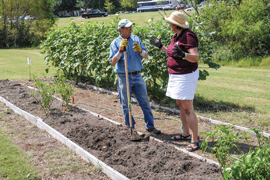
With three growing seasons, Mississippi has an ideal climate for showcasing small-scale raised beds for food production. Landscape architect Pete Melby and dietician Sylvia Byrd directed a teaching and research project to determine if household raised vegetable beds would provide the recommended amount of vegetables for a family of four. Equally important is the project's goal of demonstrating one of the key components to sustainable living: food production. Students in Melby's sustainable communities class built four 3-by-40-foot raised beds on the MSU campus and planted a spring garden. Nutrition students planted a summer garden and quantified the nutritional value of the harvests. Melby and Byrd hope their findings will inspire homeowners to plant similar gardens.
Protecting Pork

A recent study by the USDA Food Safety and Inspection Service found nearly a 10 percent increase in Salmonella incidence rate in pork trimmings. Because of this, MSU researchers sought to provide the pork industry with a natural, low-cost approach to reducing Salmonella and making meat products safer. Specifically, this involved introducing increased safeguards in the post-harvest environment. After rigorous testing, researchers saw that applying vinegar to the meat at a high temperature for a specific period of time kills Salmonella bacteria. This method offers a low-cost, natural way to keep eliminate the pathogen.
Protecting the Surface
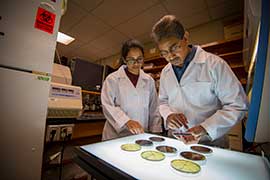
Of the many suspects that cause food safety issues in kitchens and food processing plants, biofilms, caused by bacteria such as Listeria monocytogenes and Salmonella, are a common culprit. MAFES scientists Dr. Ramakrishna Nannapaneni, who specializes in food science, nutrition and health promotion and Dr. Aaron Kiess, who specializes in poultry science, are taking a stand in biofilms, the growth of bacterial cells on surfaces that touch food. Through Nannapaneni and Kiess's research, they discovered that a mixture of disinfectants was far more effective than single compound disinfectants for removal of biofilms. Dr. Kiess's lab is also looking into how Salmonella survives on poultry processing equipment before and after cleaning cycles. They hope to continue research to determine how biofilm cells become denser, stronger, and spread as well as what mechanisms govern cross-resistance. By discovering this, they hope to figure out how these tough biofilms can be eradicated to enhance food safety.
Quartet of Care

MAFES researchers are studying the role of the barbershop in modern medicine. While the connection between haircare and healthcare may seem nebulous, this study suggests that the disarming atmosphere and relationship of care between a barber and customer could create a space for medical professionals to discuss otherwise uncomfortable aspects of human health. In particular, these researchers are interested in how barbershops can lead to a destigmatized discussion about HIV/AIDS, particularly in African American communities.
Stressed Out
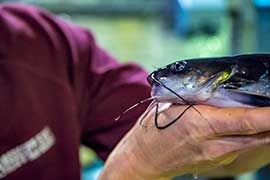
Stress can take a toll on farm-raised catfish and may also affect the end product. That's why MAFES scientists, Drs. Peter Allen and Wes Schilling, have spent five years studying the impact stress has on catfish from farm to table and fingerling to fillet. Environmental stressors included aspects of water quality, such as temperature and dissolved oxygen and sequential stressors, such as stressors in the sock (a netted enclosure) and during hauling. The stressed fish didn't eat as much or grow as fast, which resulted in smaller fillets. However, the researchers were able to determine that stress did not seem to impact the end product besides the size of the fillets. The researchers then established best practices for producers based on the research. These recommendations included minimizing harvest at elevated temperatures, reducing fish densities in hot summer conditions, and minimizing time in the sock and time from transport to processing.
Stressing Point

With the broad use of disinfectants necessitated by a pandemic, MAFES scientists hope to determine the conditions in which bacteria can develop a tolerance or resistance to the disinfectants used to kill them. After identifying and isolating the desired bacteria, various stressors were introduced, and the bacteria were observed for any changes in count and behavior. These tests showed a slight but statistically-significant increase in tolerance, which helps to present a more definite picture of how antibacterial resistance forms.
Sum of All Parts
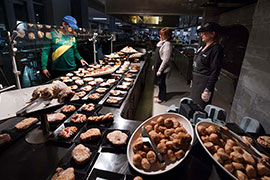
What began as a study on the genetic predisposition to umami-flavor-sensitivity among various races has become an in-depth study on how the health and lifestyle of African Americans reflects a broader trend of health disparities disproportionately affecting this population. This study utilizes a variety of survey-based data that tracks everything from the subject's typical diet to their level of food insecurity to their daily routine. With this array of information, MAFES researchers hope to identify factors that contribute to health disparities, ultimately, in order to reduce and eventually eliminate them.

